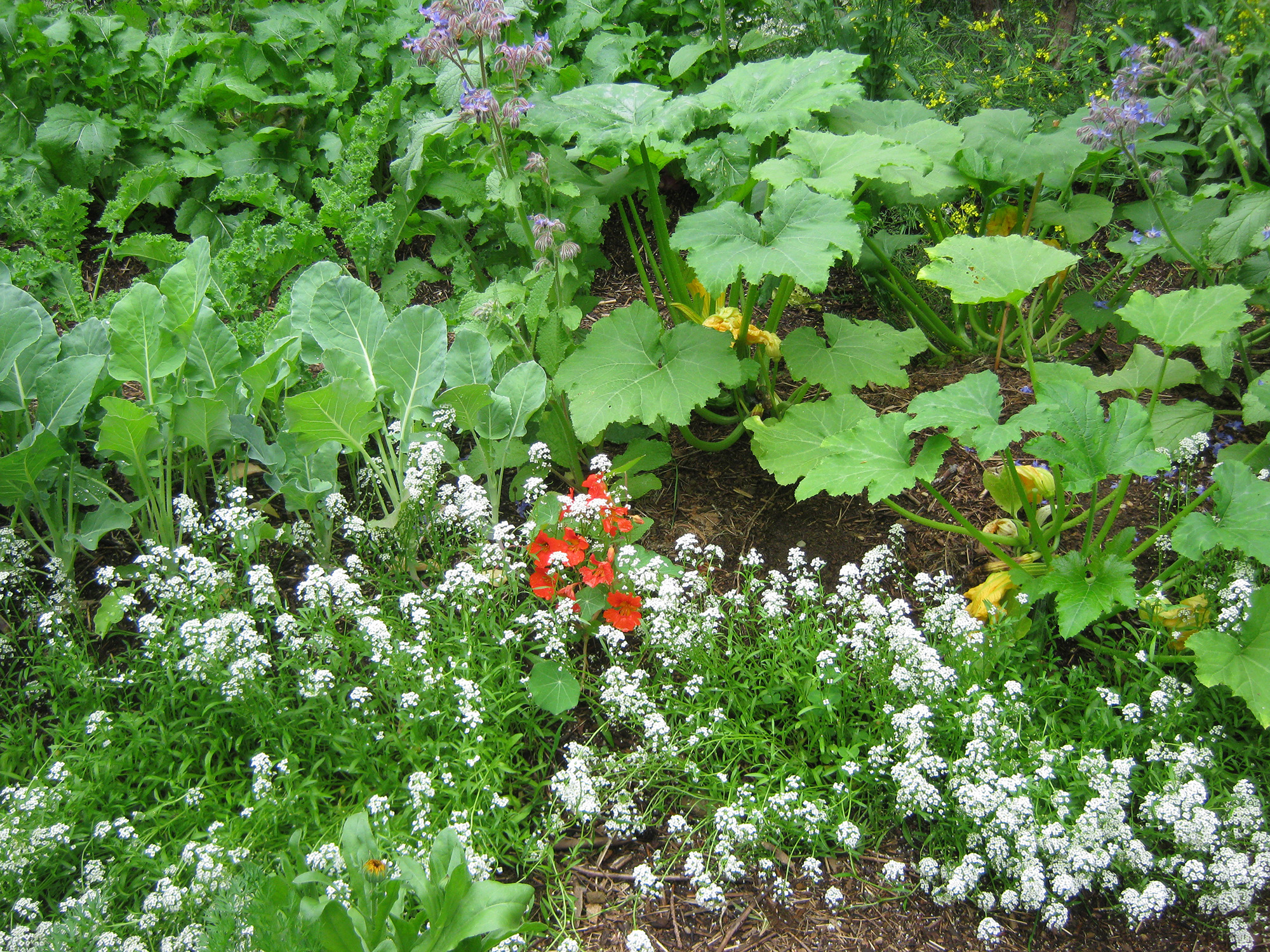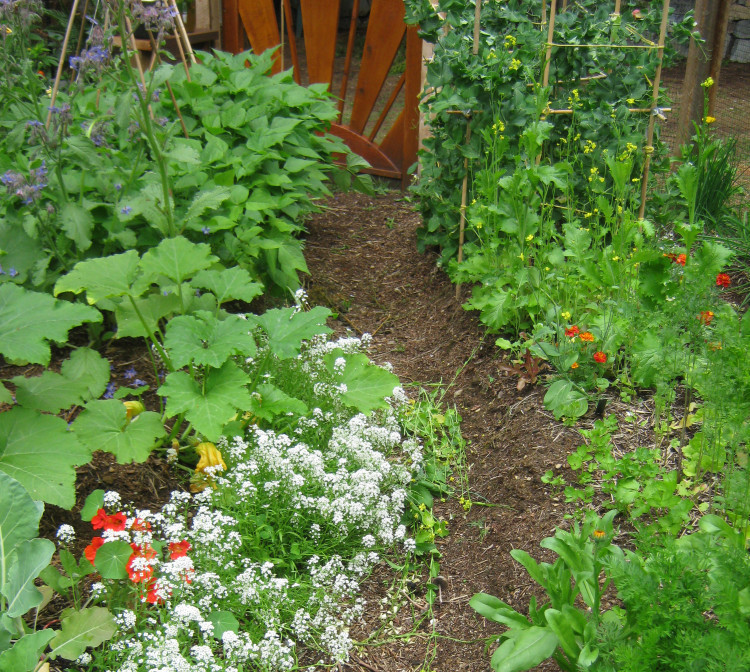Diversity is an important aspect of permaculture systems. It adds a great deal of resilience and strength, especially in your garden. How? By making sure that all the bases are covered. No matter what the weather does, or what disease or pest pressures occur, diversity can help ensure that you’ll always obtain a yield.
The more varieties of vegetables, flowers, compost, weeds, and trees you have in and around the garden, the more diversity you have added. Read on to find out how this works, and how you can add more diversity to your garden.

Plant a variety of varieties
Different vegetable varieties have different attributes. Some are bred to withstand drought, and some can stand up to cold weather. Some are resistant to this disease, and some to that. And that’s why it’s such a good idea to plant more than one variety of each vegetable.
When planting lettuce, don’t just plant one or two varieties, plant four or five. Plant two or three varieties of broccoli, kale, tomatoes, and anything else you are growing in your garden.
This will do a few things. First, it will help ensure that no matter what the weather does, one or two varieties should make it through. Some varieties are more resistant to drought, while others do well during a soggy summer.
Second, having a few different varieties can help in the face of pests and diseases. Not every variety will be susceptible to all diseases and pests. Once again, something is bound to survive a disease or pest problem.
The third bonus of planting different varieties is that they won’t all come ripe at the same time. This is a good thing for the home gardener during the growing season.
Sometimes we want all our produce to come ripe at the same time – such as when we’re canning tomatoes, or when harvesting potatoes or squash for storage.
But sometimes it’s nicer to have things come ripe at staggered times. Having different varieties of broccoli will ensure that we have broccoli coming ripe over a longer window of time.
This goes the same for many greens, turnips, beets, and carrots, to name just a few.

Bloomin’ flowers
We all want a garden filled with vegetables; but planting some flowers is always a good idea; and for a few reasons.
First, many flowers can help to confuse harmful insects. Either by their scent or their color, they mask the presence of the desired plant, confounding the dastardly insects.
Second, flowers attract beneficial insects. Many insects will eat the insects that can harm your plants. We want to attract these insects into our gardens.
Third, some flowers make excellent ground cover, helping to retain moisture. I like to plant sweet alyssum along the sunny side of the raised beds. This helps to keep weeds down, and hold moisture in.
And finally, they just look nice; and they make being in the garden much more pleasant.
5 beneficial insects, and the creepy crawlies they eat:
- Ladybugs – aphids, whiteflies, Colorado potato beetle
- Braconid wasps – aphids, caterpillars
- Minute Pirate Bugs – spider mites, aphids, caterpillars, thrips
- Green lacewings – whiteflies, aphids, leafhoppers
- Ground beetles – slugs, caterpillars, Colorado potato beetles, cutworms
Some of the plant flowers they like:
- Dandelion
- Yarrow
- Lemon balm
- Parsley
- Caraway
- Chervil
- Alfalfa
- Spearmint
- Fennel
- Coriander
- Amaranthus
- Clover

Use compost and natural amendments
Compost is a gardener’s best friend. It feeds the soil that will feed your plants; and those plants feed you.
The only way you can ensure your vegetables are highly nutritious is to make sure your soil contains all the nutrients it needs to feed your veggies.
Compost is the way to feed your soil microorganisms, and natural amendments such as bone meal and seaweed will help ensure that your soil contains all the micro nutrients necessary for healthy plants.
You really want to build your compost using a wide variety of ingredients: kitchen scraps, garden waste, weeds and grass, a variety of manures, straw, shredded leaves, wood chips, seaweed, feathers, etc. Basically, anything that was once alive can be composted.
Loading your compost with as many different ingredients as possible – creating diversity in the compost – will help you grow a healthy garden.
Don’t weed the weeds
As we all (should) know, weeds are just plants that we don’t want. Anything can become weedy – mint, comfrey, Jerusalem artichoke, etc. – so weeds are just plants that are hanging out where we don’t want them.
And many weeds can be rather helpful in the garden. Plants that have long, strong taproots are known to bring nutrients up from deeper in the soil.
They also help to break up compacted or heavy soils. Dandelions and dock are two plants that I let grow in many places in my garden.
Many of the flowers of weeds are attractive to beneficial insects, so letting them grow is helpful to the garden. The early flowering weeds such as dandelions are also important pollinator food, and should be left to flower. You can always remove the flowers just before they go to seed.
Letting weeds grow large in and around the garden will give you lots of great greenery to add to the compost pile, or use as chop-and-drop.
Weeds will put a lot of nutrients back into the soil, so use them whenever you can. Well, maybe not the bindweed or blackberries. You could probably skip those. : )

Trees and shrubs
Growing trees and shrubs in and around the garden is another super way to increase diversity in the garden.
Trees bring their own special soil microorganisms with them. They are also good friends with the mycorrhiza in the soil. This is an amazing interconnected web of fungi that help bring nutrients to your plants.
This alone is a brilliant reason to grow them near your garden. But they can also shed mulch on your garden; provide some needed shade in the heat of summer, or protection from harsh winter winds; and provide a lovely place for birds to hang out.
Birds are good to have in the garden. They eat lots of insects, and poop on the soil. Good birds.
Diversity is health
Putting elements together in such a way that they all support one another is how we build strong, resilient, successful permaculture systems. And diversity is at the base of that success.
Making your garden productive and resilient is your main concern; and diversity is a big step in that direction. I will continue to write articles about how you can make your gardens healthy, productive and resilient. I hope you’ll check back often to read them.
Did you learn anything from the article; or do you still have questions? I would be happy to help in any way I can, so leave your comments and questions in the comment box below.
Health, Hope & Happiness
Tracy
This article may contain affiliate links. If you click on a link and make a purchase, I will receive a small commission, at no extra cost to you. See the full Affiliate Disclosure here.


I love the information you are sharing. A wonderful way to garden.
Thanks! I’m glad you’re enjoying it. I hope you get some good ideas from the articles I’ve written.
Thanks muchly for stopping by and commenting.🤓
Great read! I appreciate the info for beneficial bugs and weeds. I am curious about some things: when planting several varieties of one plant, are you worried about cross polination?
Also, which plants attract slug eating bugs? Cause I have slugs yo.
Hey Savannah
When you grow different varieties, you can save seed a few ways:
only let one variety go to seed each year (snip off the buds of other varieties before they bloom)
let an early variety go to seed, and then a late variety
plant one variety in the spring, and then a different variety in the fall
You can also do some experimenting. Last year we let mustard go to seed, beside some rapini (broccoli raab). This year we have some amazing mustards happening!
As for slugs, well . . . welcome to the Wet Coast! You’ll want to invite frogs, snakes, and lizards into the garden. Leave piles of rocks around the garden. They like that. Also, have some water near the garden. Flat containers are best, with some stones in them.
Ground beetles also eat slugs, and are easily kept in the garden by leaving some little wild areas around the edge – grasses and weeds, and some rocks for them to hide under.
Here is an awesome website, all about slugs: https://www.slughelp.com/promote-biodiversity-prevent-garden-pests-like-slugs/
Hope this helps!
That helps a ton! Thanks Tracy =)